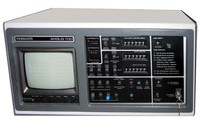Ferranti Argus 700
| Home > Browse Our Collection > Computers > Ferranti > Ferranti Argus 700 |
|
The British company Ferranti Ltd was an electrical engineering company with a long history of working on government and military contracts. It closed down in 1994 after over 100 years of operation.They created several families of computer systems used by the UK research and military establishments. Ferranti's Argus computers were a line of industrial control computers offered from the 1960s into the 1980s. They were widely used in a variety of roles in Europe, particularly in the UK where they continue to serve as monitoring and control systems for nuclear reactors. The Argus family did not contain general purpose computers: rather, they were designed to interface to other electronic systems and thereby control them. The original Argus machine was developed in 1958 for military use and was used in the Ground Station (Launch Control Post) for the Bloodhound Mk2 missile system. It later became the world's first process control computer in 1962 when it was installed at ICI to control an ammonia/soda plant. Ferranti went on to develop many models in the Argus family, which became very successful. The original Argus was developed in 1958 as a ground-based control computer for the Bristol Bloodhound Mark 2 missile. The Bloodhound had a radar dish in the nose of the missile that had to be locked down during launch due to the vibration of the solid fuel rocket boosters that got the missile up to speed. Once the boosters were burned out and ejected, the radar antenna would be unlocked and start tracking the target. The Argus calculated where the target would be relative to the missile at the point of burnout, feeding that to the missile before launch and thereby allowing it to slew the radar to the correct angle. Although originally designed solely for military use, the Argus was later selected to control the operation of an ammonia/soda plant by ICI at their Fleetwood operations in 1962. Breaking with the past, the next series of Argus machines were completely new designs and not backward compatible. The Argus 600 was an 8-bit machine, and this was followed by the Argus 700 which used 16-bit architecture. Design of the 700 started around 1968/9 and the range was still in production in the mid 1980s achieving international success for industrial and military applications. The 700 is still operational at several British nuclear power stations in 2010 in control and data processing applications. It was also used as a production control platform for companies such as Kodak. This exhibit was purchased from the MOD with the generous support of followers and friends on Twitter and FaceBook. Read More >>> Manufacturer: Ferranti Comment on This Page Ferranti Argus 700 Manuals:
Ferranti Argus 700 Articles:
Magazines RELATED to Ferranti Argus 700 in our Library
Catalogues RELATED to Ferranti Argus 700 in our Library
Other Systems Related To Ferranti Argus 700 :
This exhibit has a reference ID of CH16225. Please quote this reference ID in any communication with the Centre for Computing History. |
Click on the Image(s) For Detail
|












